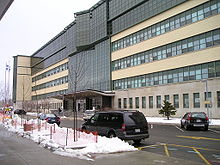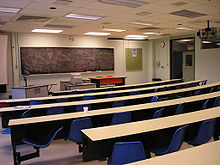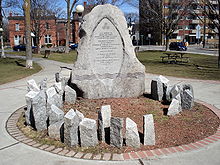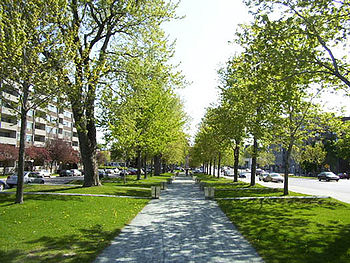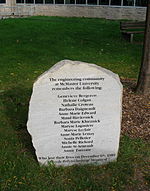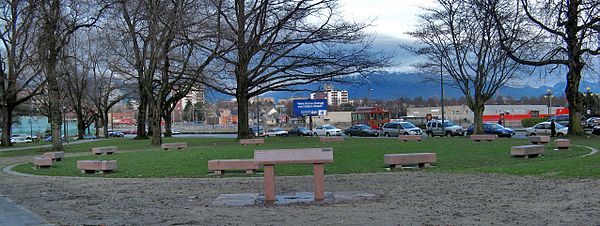- École Polytechnique massacre
-
"Polytechnique massacre" redirects here. For the film describing this event, see Polytechnique (film).
École Polytechnique massacre 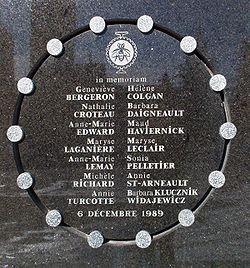
Memorial to the victims on the exterior wall of École PolytechniqueLocation  Montreal, Quebec, Canada
Montreal, Quebec, CanadaDate December 6, 1989 (UTC-4) Target École Polytechnique Attack type school shooting, massacre Death(s) 15 (including the perpetrator) Injured 14 Perpetrator(s) Marc Lépine The École Polytechnique Massacre, also known as the Montreal Massacre, occurred on December 6, 1989 at the École Polytechnique in Montreal, Quebec, Canada. Twenty-five-year-old Gamil Rodrigue Liass Gharbi, who had changed his name to Marc Lépine, armed with a legally obtained Mini-14 rifle and a hunting knife, shot twenty-eight people before killing himself. He began his attack by entering a classroom at the university, where he separated the male and female students. After claiming that he was "fighting feminism", he shot all nine women in the room, killing six. He then moved through corridors, the cafeteria, and another classroom, specifically targeting women to shoot. Overall, he killed fourteen women and injured ten other women and four men in just under twenty minutes before turning the gun on himself.[1][2] Lépine was the child of a French-Canadian mother and an Algerian father, and had been physically abused by his father. His suicide note claimed political motives and blamed feminists for ruining his life. The note included a list of nineteen Quebec women whom Lépine considered to be feminists and apparently wished to kill.[3]
Since the attack, Canadians have debated various interpretations of the events, their significance, and Lépine's motives. Many feminist groups and public officials have characterized the massacre as an anti-feminist attack that is representative of wider societal violence against women.[4][5][6] Consequently, the anniversary of the massacre has since been commemorated as the National Day of Remembrance and Action on Violence Against Women. Other interpretations emphasize Lépine's abuse as a child and his Algerian father's hatred of women's rights as elements that helped bring Lepine to the massacre. Others suggest that the massacre was simply the isolated act of a madman, unrelated to larger social issues.[7][8] Still other commentators have blamed violence in the media[9] and increasing poverty, isolation, and alienation in society,[10] particularly in immigrant communities.[11]
The incident led to more stringent gun control laws in Canada.[12] It also introduced changes in the tactical response of police to shootings, which were later credited with minimizing casualties at the Dawson College shootings.[13]
Contents
Massacre
Sometime after 4 p.m. on December 6, 1989, Marc Lépine arrived at the building housing the École Polytechnique, an engineering school affiliated with the Université de Montréal, armed with a semi-automatic rifle and a hunting knife.[1] He had purchased the Sturm, Ruger brand rifle, Mini-14 model, on November 21, 1989 in a Montreal hunting store, telling the clerk that he was going to use it to hunt small game.[14] Lépine was familiar with the layout of the building since he had been in and around the École Polytechnique at least seven times in the weeks leading up to the event.[1]
Lépine sat for a time in the office of the registrar on the second floor. He was seen rummaging through a plastic bag and did not speak to anyone, even when a staff member asked if she could help him. He left the office and was subsequently seen in other parts of the building before entering a second floor mechanical engineering class of about sixty students at about 5:10 p.m.[1] After approaching the student giving a presentation, he asked everyone to stop everything and ordered the women and men to opposite sides of the classroom. No one moved at first, believing it to be a joke until he fired a shot into the ceiling.[15]
Lépine then separated the nine women from the approximately fifty men and ordered the men to leave.[9] Speaking in French, he asked the remaining women whether they knew why they were there, and when one student replied "no," he answered: "I am fighting feminism". One of the students, Nathalie Provost, said, "Look, we are just women studying engineering, not necessarily feminists ready to march on the streets to shout we are against men, just students intent on leading a normal life." Lépine responded that "You're women, you're going to be engineers. You're all a bunch of feminists. I hate feminists." He then opened fire on the students from left to right, killing six, and wounding three others, including Provost.[1][3] Before leaving the room, he wrote the word shit twice on a student project.[9]
Lépine continued into the second floor corridor and wounded three students before entering another room where he twice attempted to shoot a female student. His weapon failed to fire so he entered the emergency staircase where he was seen reloading his gun. He returned to the room he had just left, but the students had locked the door; Lépine failed to unlock it with three shots fired into the door. Moving along the corridor he shot at others, wounding one, before moving towards the financial services office where he shot and killed a woman through the window of the door she had just locked.[1]
He next went down to the first floor cafeteria, in which about a hundred people were gathered. The crowd scattered after he shot a woman standing near the kitchens and wounded another student. Entering an unlocked storage area at the end of the cafeteria, Lépine shot and killed two more women hiding there. He told a male and female student to come out from under a table; they complied and were not shot.[1]
Lépine then walked up an escalator to the third floor where he shot and wounded one female and two male students in the corridor. He entered another classroom and told the three students giving a presentation to "get out," shooting and wounding Maryse Leclair, who was standing on the low platform at the front of the classroom. He fired on students in the front row and then killed two women who were trying to escape the room, while other students dove under their desks. Lépine moved towards some of the female students, wounding three of them and killing another. He changed the magazine in his weapon and moved to the front of the class, shooting in all directions. At this point, the wounded Leclair asked for help and, after unsheathing his hunting knife, Lépine stabbed her three times, killing her. He took off his cap, wrapped his coat around his rifle, exclaimed, "Oh shit," and then committed suicide by shooting himself in the head, twenty minutes after having begun his attack. About sixty bullets remained in the boxes he carried with him. He had killed fourteen women in total (twelve engineering students, one nursing student and one employee of the university) and injured fourteen other people, including four men.[1][2]
After briefing reporters outside, Montreal Police director of public relations Pierre Leclair entered the building and found his daughter Maryse's stabbed body.[16][17]
The Quebec and Montreal governments declared three days of mourning.[16] A joint funeral for nine of the women was held at Notre-Dame Basilica on December 11, 1989, which was attended by Governor General Jeanne Sauvé, Prime Minister Brian Mulroney, Quebec premier Robert Bourassa, and Montreal mayor Jean Doré, along with thousands of other mourners.[17]
Suicide letter
Marc Lépine's inside jacket pocket contained a suicide letter and two letters to friends, all dated the day of the massacre.[1] Some details from the suicide letter were revealed by the police two days after the event,[18][19] but the full text was not disclosed. The media brought an unsuccessful access to information case to compel the police to release the suicide letter.[20] A year after the attacks, Lépine's three-page statement was leaked to journalist and feminist Francine Pelletier. It contained a list of nineteen Quebec women whom Lépine apparently wished to kill because he considered them feminists.[21] The list included Pelletier herself, as well as a union leader, a politician, a TV personality, and six police officers who had come to Lépine's attention as they were on a volleyball team together.[22] The letter (without the list of women) was subsequently published in the newspaper La Presse, where Pelletier was a columnist at the time.[23] Lépine wrote that he considered himself rational and that he blamed feminists for ruining his life. He outlined his reasons for the attack including his anger towards feminists for seeking social changes that "retain the advantages of being women [...] while trying to grab those of the men."[24] He also mentioned Denis Lortie, a Canadian Forces corporal who killed three government employees and wounded thirteen others in an armed attack on the National Assembly of Quebec on May 7, 1984.[25] The text of the original letter in French is available, as well as an English translation.
Marc Lépine
Marc Lépine was born Gamil Gharbi to a French-Canadian mother and an Algerian father. His father, a mutual funds salesman, was contemptuous of women, and was physically and verbally abusive to his wife and son, discouraging tenderness between mother and child.[26][27] When Gamil was seven his parents separated; his father ceased contact with his children soon after.[26] His mother returned to nursing to support the family, and due to her schedule the children lived with other families during the week. At 14, he changed his name to "Marc Lépine", citing his hatred of his father as the reason for taking his mother's surname.[26] Lépine attempted to join the Canadian Army during the winter of 1980–1981, but according to his suicide letter was rejected because he was "anti-social."[28] The brief biography of Marc Lépine that police released the day after the killings described him as intelligent but troubled.[3] He disliked feminists, career women and women in traditionally male occupations, such as the police force.[28] He began a pre-university CEGEP (college) program in pure sciences in 1982 but switched to a three-year vocational program in electronics technology after his first year. He abandoned this program in his final semester without explanation.[29][30][31] Lépine applied to the École Polytechnique in 1986 and in 1989 but lacked two CEGEP courses required for admission.[32] He completed one of them in the winter of 1989.[1][12]
Search for a rationale
The massacre profoundly shocked Canadians. Government and criminal justice officials feared that extensive public discussion about the massacre would cause pain to the families and lead to antifeminist violence.[3] As a result, a public inquiry was not held,[33] and Marc Lépine's suicide letter was not officially released. In addition, though an extensive police investigation into Marc Lépine and the killings took place,[34] the resulting report was not made public, though a copy was used by the coroner as a source in her investigation.[1][35] The media, academics, women's organizations, and family members of the victims protested the lack of a public inquiry and paucity of information released.[3][9][36]
The gender of Marc Lépine's victims as well as his oral statements during the massacre and suicide note quickly led to the event being seen as an antifeminist attack and as an example of the wider issue of violence against women.[37][38] Feminist scholars consider Lépine's actions to spring from a widespread societal misogyny, including toleration of violence against women.[4][39][40] Scholars have categorized it as a "pseudo-community" type of "pseudo-commando" murder-suicide, in which the perpetrator targets a specific group, often in a public place, and intends to die in "a blaze of glory".[41] Criminologists regard the massacre as an example of a hate or bias crime against women, as the victims were selected solely because of their membership of the category of women, and those targeted were interchangeable with others from the same group.[42][43][44] Lépine's mother later wondered if the attack was not directed at her, as some would have considered her a feminist since she was a single, working mother.[27] Others, including television journalist Barbara Frum, pleaded that the massacre not be seen as an antifeminist attack or violence against women, and questioned why people insisted on "diminishing" the tragedy by "suggesting that it was an act against just one group?"[8][45]
As predicted by Marc Lépine in his suicide letter,[24] some saw the event as the isolated act of a madman.[3][8] A psychiatrist interviewed Lépine's family and friends and examined his writings as part of the police investigation. He noted that Marc Lépine defined suicide as his primary motivation, and that he chose a specific suicide method: killing one’s self after killing others (multiple homicide/suicide strategy) is considered a sign of a serious personality disorder.[1] Other psychiatrists emphasized the traumatic events of his childhood, suggesting that the blows he had received may have caused brain damage, or that Lépine was psychotic, having lost touch with reality as he tried to erase the memories of a brutal (yet largely absent) father while unconsciously identifying with a violent masculinity that dominated women.[46][47] A different theory was that Lépine's childhood experiences of abuse led him to feel victimized as he faced losses and rejections in his later life.[47] His mother wondered if Lépine might have suffered from attachment disorder, due to the abuse and sense of abandonment he had experienced in his childhood.[48]
Others expressed a broader analysis, framing Lépine's actions as the result of societal changes that had led to increased poverty, powerlessness, individual isolation,[10] and polarization between men and women.[49] Noting Lépine's interest in violent action films, some suggested that violence in the media and in society may have influenced his actions.[9] Following the shootings at Dawson College on September 13, 2006, Globe and Mail columnist Jan Wong controversially suggested that Marc Lépine may have felt alienated from Quebec society as he was the child of an immigrant.[11]Impact
The injured and witnesses among university staff and students suffered a variety of physical, social, existential, financial, and psychological consequences, including post-traumatic stress disorder. A number of students committed suicide.[50] In the suicide letters of at least two of them, the anguish they suffered following the massacre was cited as the reason for killing themselves.[50] Nine years after the event, survivors reported still being affected by their experiences, though with time some of the effects had lessened.[50]
Police response
Police response to the shootings was heavily criticized for the amount of time it gave Lépine to carry out the massacre. The first police officers to arrive at the scene established a perimeter around the building and waited before entering the building. During this period, several women were killed.[1][51] Subsequent changes to emergency response protocols led to praise of emergency responders' handling of the Dawson College shooting in 2006 in which one woman was killed by a shooter. In that incident, coordination amongst emergency response agencies and prompt intervention was credited with minimizing the loss of life.[13]
Gun control
The massacre was a major spur for the Canadian gun control movement. One of the survivors, Heidi Rathjen, who was in one of the classrooms Lépine did not enter during the shooting, organized the Coalition for Gun Control with Wendy Cukier.[12] Suzanne Laplante-Edward and Jim Edward, the parents of one of the victims, were also deeply involved.[52] Their activities, along with others, led to the passage of Bill C-68, or the Firearms Act, in 1995, ushering in stricter gun control regulations.[12] These new regulations included requirements on the training of gun owners, screening of firearm applicants, rules concerning gun and ammunition storage and the registration of all firearms. The gun registry in particular has been a controversial and partisan issue, with critics charging that it was a political move by the Liberal government of Jean Chrétien that has been expensive and impractical to enforce.[53] During 2009 and 2010 survivors of the massacre and their families publicly opposed a bill, supported by Stephen Harper's Conservative government, aimed at ending the long-gun registry;[54][55][56] Rathjen described it as "a slap in the face for the victims and families".[57] The bill was narrowly defeated in September 2010.[58]
Violence against women
The massacre galvanized the Canadian women's movement, who see it as a symbol of violence against women. "The death of those young women would not be in vain, we promised", Canadian feminist Judy Rebick recalled. "We would turn our mourning into organizing to put an end to male violence against women."[59]
In response to the killings a House of Commons Sub-Committee on the Status of Women was created. It released a report "The War against Women" in June 1991, which was not endorsed by the full standing committee.[60][61] However, following its recommendations, the federal government established the Canadian Panel on Violence Against Women in August 1991. The panel issued a final report, "Changing the Landscape: Ending Violence – Achieving Equality", in June 1993. The panel proposed a two-pronged "National Action Plan" consisting of an "Equality Action Plan" and a "Zero Tolerance Policy" designed to increase women’s equality and reduce violence against women through government policy. Critics of the panel said that the plan failed to provide a workable timeline and strategy for implementation and that with over four hundred recommendations, the final report failed to make an impact.[62]
Controversy
The feminist movement is periodically criticized for appropriating the massacre as a symbol of male violence against women. For example, Charles Rackoff, a University of Toronto computer science professor, compared those organizing vigils marking the event to the Ku Klux Klan. "The point is to use the death of these people as an excuse to promote the feminist/extreme left-wing agenda", he wrote, adding that it is "no more justified" than the KKK using the "murder of a white person by a black person as an excuse to promote their agenda."[63]
Less provocative critiques argue that Lépine was a "lone gunman" who does not represent men, and that violence against women is neither condoned nor encouraged officially or unofficially in western culture. In this perspective, feminist memorializing is considered socially divisive on the basis of gender and therefore harmful by bestowing guilt on all men, irrespective of individual propensity to violence against women.[64][65] Masculinist and anti-feminist commentators suggest that feminism has provoked violence against women, and without condoning the shootings, view the massacre as an extreme expression of men's frustrations.[66][67] A few regard Lépine as hero of men's rights, and glorify his actions.[68][69][70]
Male survivors of the massacre have been subjected to criticism for not intervening to stop Lépine. In an interview immediately after the event, a reporter asked one of the men why they "abandoned" the women when it was clear that Lépine's targets were women.[71] René Jalbert, the sergeant-at-arms who persuaded Denis Lortie to surrender during his 1984 attack, said that someone should have intervened at least to distract Lépine, but acknowledged that "ordinary citizens cannot be expected to react heroically in the midst of terror."[16] Newspaper columnist Mark Steyn suggested that male inaction during the massacre illustrated a "culture of passivity" prevalent among men in Canada, which enabled Lépine’s shooting spree: "Yet the defining image of contemporary Canadian maleness is not M Lepine/Gharbi but the professors and the men in that classroom, who, ordered to leave by the lone gunman, meekly did so, and abandoned their female classmates to their fate—an act of abdication that would have been unthinkable in almost any other culture throughout human history."[72]
Male students and staff expressed feelings of remorse for not having attempted to prevent the shootings,[9] but Nathalie Provost, one of the survivors, said that she felt that nothing could have been done to prevent the tragedy, and that her fellow students should not feel guilty.[73]Victims
- Geneviève Bergeron (born 1968), civil engineering student
- Hélène Colgan (born 1966), mechanical engineering student
- Nathalie Croteau (born 1966), mechanical engineering student
- Barbara Daigneault (born 1967), mechanical engineering student
- Anne-Marie Edward (born 1968), chemical engineering student
- Maud Haviernick (born 1960), materials engineering student
- Maryse Laganière (born 1964), budget clerk in the École Polytechnique's finance department
- Maryse Leclair (born 1966), materials engineering student
- Anne-Marie Lemay (born 1967), mechanical engineering student
- Sonia Pelletier (born 1961), mechanical engineering student
- Michèle Richard (born 1968), materials engineering student
- Annie St-Arneault (born 1966), mechanical engineering student
- Annie Turcotte (born 1969), materials engineering student
- Barbara Klucznik-Widajewicz (born 1958), nursing student
Commemoration
Since 1991, the anniversary of the massacre has been designated the National Day of Remembrance and Action on Violence Against Women, intended as a call to action against discrimination against women.[6] A White Ribbon Campaign was launched in 1991 by a group of men in London, Ontario, in wake of the massacre, for the purpose of raising awareness about the prevalence of male violence against women, with the ribbon symbolizing "the idea of men giving up their arms."[74] Commemorative demonstrations are held each year on December 6 across the country in memory of the slain women and numerous memorials have been assembled.[24] In commemoration of the event, December 6 is a day off every year in Polytechnique.
The Place du 6-Décembre-1989 in the Côte-des-Neiges/Notre-Dame-de-Grâce borough of Montreal was created as a memorial to the victims of the massacre. Located at the corner of Decelles Avenue and Queen Mary Road, a short distance from the university, it includes the art installation Nef pour quatorze reines (Nave for Fourteen Queens) by Rose-Marie Goulet.[75] It is the site of annual commemorations on December 6.[76]
A memorial erected in Vancouver sparked controversy because it was dedicated to "all women murdered by men", which critics say implies all men are potential murderers.[77] As a result, women involved in the project received death threats and the Vancouver Park Board subsequently banned any future memorials that might "antagonize" other groups.[78][79]
The event has also been commemorated through references in television, theatre, and popular music. A play about the shootings by Adam Kelly called The Anorak was named as one of the best plays of 2004 by the Montreal Gazette.[80] A movie entitled Polytechnique, directed by Denis Villeneuve was released in 2009, and sparked controversy over the desirability of reliving the tragedy in a commercial film.[81][82]
Additionally, several songs have been written about the events in different musical genres, including "Montreal Massacre" by the death metal band Macabre, "This Memory" by the folk duo the Wyrd Sisters, and "14 (for December 6)" by spoken-word artist Evalyn Parry.
In 2008, Marc Lépine's mother Monique published Aftermath, a memoir of her own journey through the grief and pain of the incident. She had stayed silent until 2006, when she decided to speak out for the first time in the wake of that year's Dawson College shooting.[83]
See also
- List of massacres in Canada
References
- ^ a b c d e f g h i j k l m Sourour, Teresa K., (1991) Report of Coroner's Investigation (PDF). Retrieved on December 28, 2006
- ^ a b Buchignani, Walter (December 8, 1989). "Amid the tragedy, miracles of survival". The Gazette (Montreal): p. A3.
- ^ a b c d e f Chun, Wendy Hui Kyong (1999). "Unbearable Witness: towards a Politics of Listening". Journal of Feminist Cultural Studies 11 (1): 112–149.
- ^ a b Young, Katherine K.; Nathanson, Paul (2006). Legalizing Misandry: From Public Shame to Systematic Discrimination Against Men. Montreal: McGill-Queen's University Press. pp. 59–61. ISBN 0-7735-2862-8. http://books.google.com/?id=cqKxhhu55SMC&pg=PA59.
- ^ Conway, John Frederick (2003). The Canadian Family in crisis. James Lorimer and Company. pp. 163–64. ISBN 978-1-55028-798-1. http://books.google.com/?id=-Spqsukv9aQC&pg=PA163.
- ^ a b Fitzpatrick, Meagan (December 6, 2006). "National day of remembrance pays tribute to victims of Montreal massacre". CanWest News Service. http://www.canada.com/topics/news/national/story.html?id=dcb98c06-2c4f-46f1-bc6f-6a147308a252&k=33060. Retrieved December 27, 2006.
- ^ Eglin & Hester 2003, pp. 54–55.
- ^ a b c Conway, John Frederick (2003). The Canadian family in crisis. James Lorimer and Company. p. 164. ISBN 978-1-55028-798-1. http://books.google.com/?id=-Spqsukv9aQC&pg=PA164.
- ^ a b c d e f Cernea, Adrian (1999). Poly 1989: Témoin de l'horreur. Éditions Lescop. ISBN 2-9804832-8-1.
- ^ a b Valpy, Michael (December 11, 1989). "Litany of social ills created Marc Lepine". The Globe and Mail. p. A8.
- ^ a b Wong, Jan (September 16, 2006). "Get under the desk". The Globe and Mail.
- ^ a b c d Rathjen, Heidi; Charles Montpetit (1999). December 6: From the Montreal Massacre to Gun Control. Toronto: McClelland & Stewart. ISBN 0-7710-6125-0.
- ^ a b Rakobowchuk, Peter (September 14, 2006). "Lessons learned from 1989 Montreal massacre help save lives at Dawson college". Canadian Press. http://cnews.canoe.ca/CNEWS/Canada/2006/09/14/1839448-ap.html. Retrieved December 28, 2006.[dead link]
- ^ {{cite news|last =Weston| first =Greg| title =Why? We may never know| publisher =Toronto Sun| date = September 14, 2006| url =
- ^ "Gunman massacres 14 women" (video stream). Archives. CBC. December 6, 1989. http://archives.cbc.ca/society/crime_justice/topics/398-2235/. Retrieved December 29, 2006.
- ^ a b c Came, Barry; Burke, D, Ferzoco, G., O'Farreli, B, Wallace, B (December 18, 1989). "Montreal Massacre: Railing Against Feminists". Maclean's Magazine. http://www.rapereliefshelter.bc.ca/dec6/macleans.html. Retrieved January 4, 2007.[dead link]
- ^ a b Mennie, James; and Bauch, Hubert (December 12, 1989). "A quiet goodbye for slain women". The Gazette (Montreal): p. A1.
- ^ Malarek, Victor (December 12, 1989). "More Massacre Details to be Released by Police, but an Inquiry Ruled Out". Globe and Mail: p. A6.
- ^ Malarek, Victor (December 8, 1989). "Killer's letter blames feminists". Globe and Mail: p. A7.
- ^ McIntosh, Andrew (August 22, 1990). "Marc Lepine's suicide note to stay sealed; Commission says it can't order police to reveal mass murderer's letter". The Gazette: p. A3.
- ^ "A Difficult Story to Tell". The Story of the Fifth Estate. CBC News. http://www.cbc.ca/fifth/history/difficultfour.html. Retrieved December 28, 2006.
- ^ Fitterman, Lisa (March 10, 1999). "Cops on Lepine's list: Names of six female officers found on Polytechnique killer". The Gazette: p. A3.
- ^ Pelchat, Martin (November 24, 1990). "Lépine avait des motifs "politiques"" (in French). La Presse: p. A1.
- ^ a b c "CityNews Rewind: The Montreal Massacre". City News. December 6, 2006. http://www.citytv.com/toronto/citynews/news/local/article/24921--citynews-rewind-the-montreal-massacre. Retrieved December 28, 2006.
- ^ Eglin & Hester 2003, p. 58
- ^ a b c Weston, Greg; Aubry, Jack (February 7, 1990). "The making of a massacre: The Marc Lepine story Part I". The Ottawa Citizen.
- ^ a b CTV.ca News Staff (September 18, 2006). "Mother of Marc Lepine finally breaks her silence". CTV. http://www.ctv.ca/servlet/ArticleNews/print/CTVNews/20060925/lepine_mother_060925/20060925/?hub=Canada&subhub=PrintStory. Retrieved January 1, 2007.
- ^ a b Malarek, Victor (December 9, 1989). "Killer Fraternized with Men in Army Fatigues". quoted in "The Montreal Massacre: A Story of Membership Categorization Analysis", eds., P. Eglin and S. Hester (2003) (Globe and Mail). http://books.google.com/books?id=FHZJxbjlHsgC&pg=RA1-PA41&lpg=RA1-PA41&dq=%22killer+fraternized+with+men+in+army+fatigues%22&source=web&ots=BCcpaVbwAv&sig=qvo9cTTu89_ywX5a-2EzlnN7TRs#PRA1-PA41,M1. Retrieved January 2, 2007.
- ^ McDonnell, Rod; Thompson, Elizabeth, McIntosh, Andrew, and Marsden, William (December 12, 1989). "Killer's father beat him as a child; A brutal man who didn't seem to have any control of his emotions". The Gazette (Montreal): p. A1.
- ^ Weston, Greg; and Aubry, Jack (February 8, 1990). "The making of a massacre: The Marc Lepine story Part II". The Ottawa Citizen. p. A1.
- ^ Colpron, Suzanne (December 9, 1989). "Marc Lépine était un premier de classe". La Presse.
- ^ Lépine & Gagné 2008, pp. 170–71
- ^ Malarek, Victor (December 12, 1989). "More Massacre Details to be Released by Police, but an Inquiry Ruled Out". Globe and Mail. p. A14.
- ^ Canadian Press (January 12, 1990). "Police scour the life of mass killer". Edmonton Journal: p. B9.
- ^ Poirier, Patricia (March 1, 1990). "Police can't find cause for Lepine's rampage on Montreal campus". Globe and Mail. p. A17.
- ^ Canadian Press (May 30, 1990). "Parents fear coverup over murdered 14". Toronto Star: p. A15.
- ^ Eglin & Hester 2003, pp. 65–88.
- ^ Fox, James Alan; Levin, Jack (January 2003). "Mass Murder: An Analysis of Extreme Violence". Journal of Applied Psychoanalytic Studies 5 (1): 47–64. doi:10.1023/A:1021051002020.
- ^ Mancini Billson, Janet (2005). "After the Montreal massacre: gender and the pervasiveness of violence". In Janet Mancini Billson, Carolyn Fluehr-Lobban. Female well-being: toward a global theory of social change. Zed Books. pp. 104–05. ISBN 978-1-84277-009-2. http://books.google.com/?id=a_2eWZK63_8C&pg=PA104.
- ^ Brickman, Julie (1996). "Female lives, Feminist deaths". In Curry, Renée R.; Allison, Terry L.. States of rage: emotional eruption, violence, and social change. New York: New York University Press. ISBN 0-8147-1530-3. http://books.google.com/?id=kp0EjoLkmssC&pg=PA27.
- ^ Byard, Roger W. (2005). "Murder-Suicide". In Tsokos, Michael. Forensic Pathology Reviews. 3. Humana Press. p. 343. ISBN 978-1-58829-416-6. http://books.google.com/?id=323vT9cEaSoC&pg=PA343.
- ^ Gerstenfeld, Phyllis B. (2004). Hate crimes: causes, controls, and controversies. SAGE. pp. 48–49. ISBN 978-0-7619-2814-0. http://books.google.com/?id=sJ7OkVzwVMEC&pg=PA49.
- ^ Perry, Barbara, ed (2003). "Gender-bias hate crimes- a review". Hate and Bias Crime: A Reader. Routledge. p. 271. ISBN 978-0-415-94408-3. http://books.google.com/?id=zLtnNmAt9dwC&pg=PA271.
- ^ Lawrence, Frederick M. (2002). Punishing Hate: Bias Crimes Under American Law. Harvard University Press. pp. 15–17. ISBN 978-0-674-00972-1. http://books.google.com/?id=959sKkDoLhoC&pg=PT31#v=onepage&q=.
- ^ Ruddy, Jenny; Elizabeth Curry (December 2004). "Barbara Frum, quoted in Reframing violence against women". The Commonwealth. Saskatchewan New Democrat Party. http://www.saskndp.com/cw/64.5/reframingviolencewomen.html. Retrieved December 29, 2006.
- ^ Fox, James Alan; Levin, Jack (2005). Extreme killing: Understanding serial and mass murder. Sage Publications. pp. 227–230. ISBN 0-7619-8857-2.
- ^ a b Lortie, Marie-Claude (December 1, 1990). "Poly un an après : Psychose? Blessures au cerveau? Les spécialistes n'ont pas encore résolu l'énigme Marc Lépine". La Presse: p. B7.
- ^ Lépine & Gagné 2008, pp. 138, 161–62
- ^ Young, Katherine K.; Nathanson, Paul (2006). Legalizing misandry: from public shame to systematic discrimination against men. Montreal: McGill-Queen's University Press. p. 62. ISBN 0-7735-2862-8. http://books.google.com/?id=cqKxhhu55SMC&pg=PA62.
- ^ a b c Parent, G; Cousineau, M (2003). "Conséquences à long terme d'un mass murder: le cas de Polytechnique, neuf ans plus tard". The International Journal of Victimology 1 (3). http://www.jidv.com/njidv/index.php?option=com_content&view=article&id=189:consequences-a-long-terme-dun-mass-murder-le-cas-de-polytechnique-neuf-ans-plus-tard&catid=109:jidv03&Itemid=391. Retrieved December 29, 2006.
- ^ Sheppard, Robert (September 15, 2006). "A sea change in police tactics when it comes to gunmen". CBC News. http://www.cbc.ca/news/background/realitycheck/sheppard/20060915.html. Retrieved December 29, 2006.
- ^ Boyd, Denny (April 20, 1992). "Couple salvages purpose from their daughter's tragic death". The Vancouver Sun. p. B1.
- ^ Dixon, John (January 8, 2003). "A gang that couldn't shoot straight". The Globe and Mail. http://www.lowe.ca/Rick/FirearmsLegislation/AGangThatCouldn'tShootStraight.html. Retrieved April 21, 2007.
- ^ Delacourt, Susan (December 5, 2009). "Long-gun registry politics taint service for the victims". Toronto Star. http://www.thestar.com/news/canada/article/734816--long-gun-registry-politics-taint-service-for-the-victims. Retrieved 2009-12-06.
- ^ Fedio, Chloe (September 21, 2010). "A mother’s battle to save the long-gun registry". Toronto Star. http://www.thestar.com/news/canada/article/864488--a-mother-s-battle-to-save-the-long-gun-registry. Retrieved 2010-11-06.
- ^ Stone, Laura (May 6, 2010). "Police rift emerges over long-gun registry". National Post. http://www.nationalpost.com/most-popular/story.html?id=2995715. Retrieved 6 November 2010.
- ^ Peritz, Ingrid (December 6, 2009). "'A slap in the face' for victims". The Globe and Mail. http://www.theglobeandmail.com/news/national/a-slap-in-the-face-for-victims/article1390008/. Retrieved 2009-12-06.
- ^ Campion-Smith, Bruce and Whittington, Les (September 22, 2010). "Long-gun registry survives tight Commons vote". Toronto Star. http://www.thestar.com/news/canada/gunregistry/article/864804--long-gun-registry-survives-tight-commons-vote. Retrieved 2010-11-06.
- ^ Rebick, Judy (December 6, 2000). "Where's the funding for abused women?". CBC. Archived from the original on March 21, 2007. http://web.archive.org/web/20070321225539/http://www.cbc.ca/news/viewpoint/columns/rebick/rebick001206.html. Retrieved March 7, 2007.
- ^ Vienneau, David (January 19, 1991). "Probe on violence toward women blocked". Toronto Star. p. A4.
- ^ Hooks, Tess; LeClerc, Patrice; Beaujot, Roderic (2005). "Women in Canada: a century of struggle". In Janet Mancini Billson, Carolyn Fluehr-Lobban. Female well-being: toward a global theory of social change. Zed Books. pp. 102–103. ISBN 978-1-84277-009-2. http://books.google.com/?id=a_2eWZK63_8C&pg=PA102.
- ^ Harder, Sandra. "Violence against women: the Canadian Panel's final report". Government of Canada. http://dsp-psd.communication.gc.ca/Collection-R/LoPBdP/MR/mr122-e.htm. Retrieved 2007-02-03.
- ^ CBC news (December 7, 2000). "Professor criticizes Montreal massacre memorials". CBC. http://www.cbc.ca/canada/story/2000/12/07/massacre_email001207.html. Retrieved March 7, 2007.
- ^ Kay, Barbara (December 6, 2006). "Lone gunman: The Ecole Polytechnique massacre was a freak tragedy. So why is every man made to feel guilty for it?". National Post. http://www.nationalpost.com/news/story.html?id=75e56e58-5238-4d65-82ff-e87f841303e3. Retrieved March 7, 2007.
- ^ Young, Katherine K.; Nathanson, Paul (2006). Legalizing misandry: from public shame to systematic discrimination against men. Montreal: McGill-Queen's University Press. pp. 61–62. ISBN 0-7735-2862-8. http://books.google.com/?id=cqKxhhu55SMC&pg=PA61.
- ^ Conway, John Frederick (2003). The Canadian family in crisis. James Lorimer and Company. p. 166. ISBN 978-1-55028-798-1. http://books.google.com/?id=-Spqsukv9aQC&pg=PA166.
- ^ Helene Meyers (2001). Femicidal fears: narratives of the female gothic experience. Albany, N.Y: State University of New York Press. pp. 3–4. ISBN 0-7914-5151-8. http://books.google.com/?id=--9KqttWVEsC&pg=PA3.
- ^ Mélissa Blais (2008). "Marc Lépine: heros ou martyr? Le masculinisme et la tuerie de l'École polytechnique". In Blais, Mélissa and Dupuis-Déri, Francis. Le mouvement masculiniste au Québec. Les Éditions du remue-ménage. pp. 86–92. ISBN 0-670-06969-8.
- ^ Nicoud, Anabelle (12 November 2009). "Des disciples de Marc Lépine font fuir un réalisateur". La Presse. http://moncinema.cyberpresse.ca/nouvelles-et-critiques/nouvelles/nouvelle-cinema/9968-des-disciples-de-marc-lepine-font-fuir-un-realisateur.html. Retrieved 20 November 2009.
- ^ Hanes, Alison (2 December 2005). "Man threatens to repeat Montreal massacre". Ottawa Citizen: p. A9.
- ^ Lakeman, Lee. "Women, Violence and the Montreal Massacre". Vancouver Rape Relief and Women’s Shelter. http://www.rapereliefshelter.bc.ca/dec6/leearticle.html. Retrieved April 20, 2007.
- ^ Steyn, Mark (April 18, 2007). "A Culture of Passivity". National Review. http://article.nationalreview.com/?q=YzEzYzQ0Y2MyZjNlNjY1ZTEzMTA0MGRmM2EyMTQ0NjY=. Retrieved April 20, 2007.
- ^ Kastor, Elizabeth (December 11, 1989). "In Montreal, A Survivor Heals After The Horror; 23-Year-Old Student Tried To Reason With Killer". The Washington Post: p. B1.
- ^ "Men wearing white ribbons". CBC. November 27, 1991. http://archives.cbc.ca/society/crime_justice/topics/398-2240/. Retrieved March 7, 2007.
- ^ CBC news (December 5, 1999). "Monument to slain women unveiled". CBC. Archived from the original on November 11, 2007. http://web.archive.org/web/20071111062104/http://www.cbc.ca/news/story/1999/12/05/memorialsun991205.html. Retrieved January 4, 2007.
- ^ Young, Katherine K.; Nathanson, Paul (2006). Legalizing misandry: from public shame to systematic discrimination against men. Montreal: McGill-Queen's University Press. pp. 69–70. ISBN 0-7735-2862-8. http://books.google.com/?id=cqKxhhu55SMC&pg=PA69.
- ^ Campbell, Charles (November 11, 2004). "Magnets for Memory". The Tyee. http://thetyee.ca/Life/2004/11/11/MagnetsforMemory/. Retrieved December 31, 2006.
- ^ Cooper, Rachelle (April 19, 2006). "Book a Monument to Canadian Women Murdered by Men". at Guelph. http://www.uoguelph.ca/atguelph/06-04-19/. Retrieved December 31, 2006.
- ^ Ingram, Gordon Brent (February 2, 2000). "Contests over social memory in waterfront Vancouver: Historical editing & obfuscation through public art". on the w@terfront. http://gordonbrentingram.ca/scholarship/wp-content/uploads/2008/11/ingram-2000-contests-over-social-memory-in-waterfront-vancouver.pdf. Retrieved December 31, 2006.
- ^ "Stage Productions: The Anorak". Queen's University Faculty of Applied Science. http://appsci.queensu.ca/ilc/events/playwritingcomp/anorak.php. Retrieved July 21, 2007.
- ^ Kelley, Brendan (January 1, 2009). "Polytechnique: open to debate". Montreal Gazette (Canwest). http://www.montrealgazette.com/news/Polytechnique+open+debate/1236248/story.html. Retrieved February 1, 2009.[dead link]
- ^ Hamilton, Graeme (January 28, 2009). "Montreal massacre film brings up 'too many memories'". National Post. http://www.nationalpost.com/related/topics/Montreal%2Bmassacre%2Bfilm%2Bbrings%2Bmany%2Bmemories/1228750/story.html. Retrieved November 7, 2010.
- ^ "Monique Lépine marks Montreal Massacre anniversary". cbc.ca. December 2, 2009. http://www.cbc.ca/canada/montreal/story/2009/12/02/montreal-massacre-lepine-gunman-mother.html. Retrieved August 21, 2011.
Further reading
- Eglin, Peter; Hester, Stephen (2003). The Montreal Massacre: A Story of Membership Categorization Analysis. Wilfrid Laurier University Press. ISBN 0-88920-422-5. http://books.google.ca/books?id=FHZJxbjlHsgC&lpg=PP1&dq=Montreal%20Massacre&pg=PP1#v=onepage&q&f=true.
- M O'Donovan, Theresa (2007). Rage and Resistance: A Theological Reflection on the Montreal Massacre. Wilfrid Laurier University Press. ISBN 978-0-88920-522-2. http://books.google.ca/books?id=IwR7hQlbF8UC&lpg=PA5&dq=Montreal%20Massacre&pg=PP1#v=onepage&q&f=true.
- Lépine, Monique; Gagné, Harold (2008). Aftermath. Viking Canada. ISBN 978-0-670-06969-9.
External links
Coordinates: 45°30′17″N 73°36′46″W / 45.50472°N 73.61278°W
History of Montreal Topics Hochelaga · Fort Ville-Marie · Notre-Dame de Montréal · Governor of Montreal · Hôtel-Dieu · Saint-Sulpice Seminary · Battle of Long Sault · Old Montreal · Great Peace of Montreal · Citadel · Grey Nuns · 1732 earthquake · Capitulation of Montreal · American occupation · North West Company · Bank of Montreal · Lachine Canal · List of Mayors · Burning of the Parliament · Gavazzi Riots · Victoria Bridge · Golden Square Mile · Oldest buildings · Ouimetoscope · St. Lawrence Seaway · Expo 67 · Sir George Williams Computer Riot · Murray-Hill riot · October Crisis · Montreal Urban Community · 1976 Summer Olympics · Overdale · Montreal Protocol · École Polytechnique massacre · Montreal merger · Dawson College shooting · National Historic Sites in Montreal
Timeline Pre-European period • 16th Century • 1600s • 1610s • 1620s • 1630s • 1640s • 1650s • 1660s • 1670s • 1680s • 1690s • 1700s • 1710s • 1720s • 1730s • 1740s • 1750s • 1760s • 1770s • 1780s • 1790s • 1800s • 1810s • 1820s • 1830s • 1840s • 1850s • 1860s • 1870s • 1880s • 1890s • 1900s • 1910s • 1920s • 1930s • 1940s • 1950s • 1960s • 1970s • 1980s • 1990s • 2000sCategories:- 1989 in Canada
- Mass murder in 1989
- Crime in Montreal
- Disasters in Quebec
- School killings in Canada
- Massacres in Canada
- Université de Montréal
- University shootings
- History of Canada (1982–1992)
- Violence against women
- Gender studies
- Misogyny
- History of Montreal
- Deaths by firearm in Quebec
- Spree shootings in Canada
Wikimedia Foundation. 2010.

